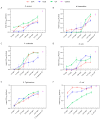Highly Specific Polyphenolic Colloids as Alternatives to Antimicrobials in Livestock Production
- PMID: 39273312
- PMCID: PMC11395071
- DOI: 10.3390/ijms25179363
Highly Specific Polyphenolic Colloids as Alternatives to Antimicrobials in Livestock Production
Abstract
The dispersion of antibiotics in livestock farming represents a health concern worldwide, contributing to the spread of antimicrobial-resistant bacteria through animals, the environment, and humans. Phenolic compounds could be alternatives to antibiotics, once drawbacks such as their low water solubility, bioavailability, and reduced stability are overcome. Although nano- or micro-sized formulations could counter these shortcomings, they do not represent cost-effective options. In this study, three phenolic compounds, obtained from wood-processing manufacturers, were characterized, revealing suitable features such as their antioxidant activity, size, and chemical and colloidal stability for in-field applications. The minimum inhibitory concentration (MIC) of these colloidal suspensions was measured against six bacterial strains isolated from livestock. These particles showed different inhibition behaviors: Colloidal chestnut was effective against one of the most threatening antibiotic-resistant pathogens, i.e., S. aureus, but ineffective toward E. coli. Instead, colloidal pine showed a weak effect on S. aureus but specificity toward E. coli. The present proof-of-concept points at colloidal polyphenols as valuable alternatives for antimicrobial substitutes in the livestock context.
Keywords: AMR; antimicrobials; nanoparticles; wood industry by-products.
Conflict of interest statement
The authors declare no conflicts of interest.
Figures




References
-
- Billen G., Aguilera E., Einarsson R., Garnier J., Gingrich S., Grizzetti B., Lassaletta L., Le Noë J., Sanz-Cobena A. Reshaping the European Agro-Food System and Closing Its Nitrogen Cycle: The Potential of Combining Dietary Change, Agroecology, and Circularity. One Earth. 2021;4:839–850. doi: 10.1016/j.oneear.2021.05.008. - DOI
MeSH terms
Substances
Grants and funding
- "Sentinel" and "Ecosistema dell'Innovazione"/Italian Ministry of Education, University and research (MIUR)
- by REACT-EU PON "Ricerca e Innovazione 2014-2020"/Italian Ministry of Education, University and research (MIUR)
- "Supporting TAlent in ReSearch @ University of Padua - STARS Grants" 2023/University of Padua
- "iNEST- Interconnected Nord-Est Innovation ECS00000043"./Italian Ministry of Education, University and research (MIUR) funds
LinkOut - more resources
Full Text Sources

